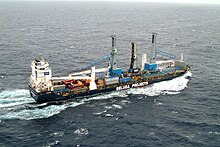Beluga R series
|
The Beluga Resolution
|
||||||||||||||||
|
||||||||||||||||
|
||||||||||||||||
|
||||||||||||||||
|
||||||||||||||||
|
||||||||||||||||
The R series is a class of four multi-purpose ships owned by the Hammonia shipping company in Hamburg and the former Bremen heavy lift shipping company Beluga Shipping .
history
The series was designed by the shipping companies Beluga in Bremen and Hammonia in Hamburg in 2001 and commissioned the following year. The ship's design was designed by the Volharding Shipyards in Westerbroek as a multi-purpose heavy lift cargo ship with its own loading gear , aft deckhouse and two holds . The construction of the ships began in the same year at the Volharding shipyard in Hoogezand, with three hulls from the Romanian shipyard Daewoo Mangalia . All four units were delivered in 2005 and initially used by the Bremen shipping company Beluga. The designation of the ship series results from the ship names which, during the operation by the Beluga shipping company, consisted of a preceding "Beluga" and a subsequent term beginning with the letter "R". After the collapse of the Beluga Group, the R-series ships remained in the possession of the Hammonia shipping company, which also took over the management of the ships from 2011 and renamed the four units by replacing the Beluga in the ship's name with the abbreviation HR .
The ships are mainly used in global voyages for the transport of heavy cargo, general cargo, smaller project cargoes or containers. At Beluga, the four units served as training ships . A deck with four double chambers and dedicated computers for eight interns or trainees was provided on board the ships, on which there was also a large classroom with a specialist library. A training officer accompanying the crew gave two hours of instruction a day.
The command of the type ship of the R series, the Beluga Revolution , was taken over in February 2009 by the first female captain of the Beluga fleet, Antje-Friederike Herbst .
Maritime casualty of the Beluga Revolution
On a trip from Noumea in New Caledonia to Pohang in South Korea , the Beluga Revolution ran aground on April 30, 2010 on the island of Tench , which belongs to Papua New Guinea , because the map course was almost over the 50 hectare small island and neither the captain nor the officers on watch allowed it noticed at some point. After being removed from the stranding site, the damaged ship was able to continue its voyage.
technology
The volume of the two holds amounts to a total of 14,951 m 3 ; if the removable intermediate deck elements are taken along, a volume of 13,616 m 3 remains . The tank cover is designed for loads of 15 tons / m 2 and reinforced with grabs for cargo handling. The displaceable tween decks may also be used as a grain bulkheads and are provided with up to three tonnes / m 2 under pressure, the hatch cover with 3.5 to 4 ton / m 2 . The container capacity is 547 TEU (or 242 FEU and 50 TEU) if the tween deck elements are not stowed on board. The ships are equipped with two electrohydraulic NMF ship cranes attached to port, each with a lifting capacity of 250 tons, which can move packages of up to 500 tons in coupled operation . The holds of the ships are closed with hydraulically operated folding hatch covers. The forecastle of the ships is covered and turns into a breakwater at the aft edge.
The driving of vessels consists of a four-stroke diesel engine of the type MaK 8M43 7200 kW power, via a reduction gear to a variable pitch propeller and a wave generator operating with 750 kVA. The ships reach a speed of around 17 knots . There are also two Scania auxiliary diesels, each with 375 kW or 438 kVA output, and a Scania emergency diesel with 375 kW or 438 kVA output. The mooring and casting off maneuvers are supported by a bow thruster with an output of 650 kW.
The ships
| Beluga R series | |||||
|---|---|---|---|---|---|
| Building name | Shipyard / construction number | IMO number |
Keel laying, launching, delivery |
Client | Renaming and whereabouts |
| Beluga revolution | Volharding / 549 | 9267742 | June 11, 2002 July 6, 2004 March 14, 2005 |
Beluga Shipping, Bremen Hammonia Reederei, Hamburg |
2011 HR Revolution , Industrial Revolution |
| Beluga Resolution | Daewoo Mangalia / 4039 Volharding / 550 |
9267754 | June 17, 2002 September 26, 2004 July 1, 2005 |
Beluga Shipping, Bremen Hammonia Reederei, Hamburg |
2011 HR Resolution , Industrial Royal |
| Beluga Recommendation | Daewoo Mangalia / 4040 Volharding / 552 |
9277292 | June 19, 2002 November 14, 2004 October 21, 2005 |
Beluga Shipping, Bremen Hammonia Reederei, Hamburg |
2011 HR Recommendation , Industrial Ruby |
| Beluga Recognition | Daewoo Mangalia / 4041 Volharding / 551 |
9277280 | June 21, 2002 March 27, 2005 December 21, 2005 |
Beluga Shipping, Bremen Hammonia Reederei, Hamburg |
2011 HR Recognition , Industrial Ranger |
| Data: Equasis, large tonnage | |||||
Individual evidence
- ^ Hermannus Pfeiffer: The captain of the "Revolution" . In: Neues Deutschland from March 31, 2010; Retrieved June 6, 2011.
- ↑ Federal Bureau of Maritime Casualty Investigation: Stranding of the MS Beluga Revolution on Enus (Tench) Island in the South Pacific on April 30, 2010 , investigation report 174/10 of August 1, 2011
- ↑ Equasis homepage (English)
- ↑ grosstonnage homepage (English)


